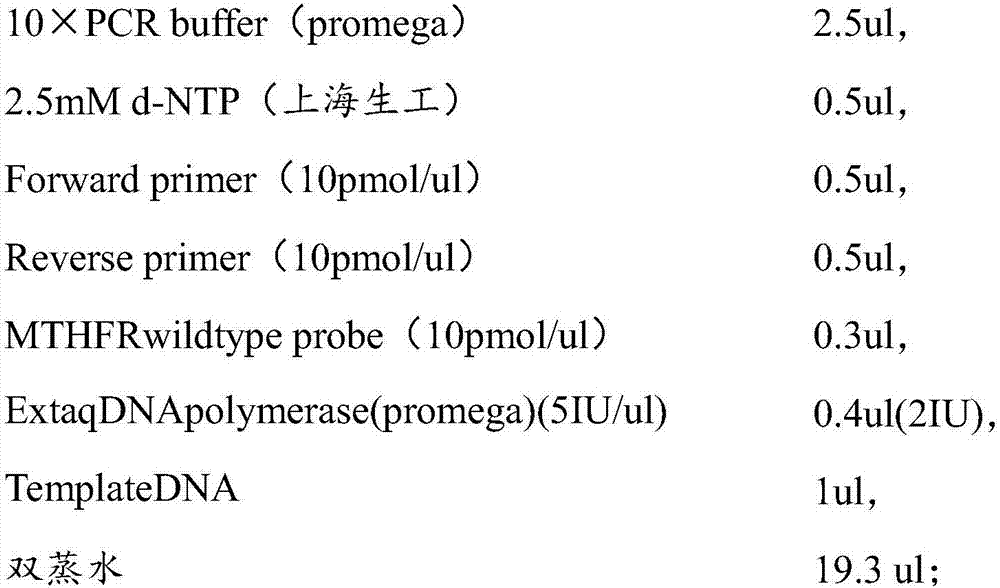Primer pair, probe and kit used for detecting polymorphism of MTHFR gene
A gene polymorphism and primer pair technology, applied in the field of molecular biology, can solve the problems of easy contamination of reaction products and high detection cost, and achieve the effects of shortening the time required for detection, avoiding pollution and reducing errors.
- Summary
- Abstract
- Description
- Claims
- Application Information
AI Technical Summary
Problems solved by technology
Method used
Image
Examples
Embodiment 1
[0033] Example 1. Primer pair for detecting polymorphism of MTHFR gene
[0034] In this example, a primer pair was designed for the c.677 position of the MTHFR gene.
[0035] The primer pair was designed according to the rs1801133 sequence (SEQ ID No. 5), the sequence of the primer pair is as follows:
[0036] Forward primer (SEQ ID No. 1): 5'C (amino group) TTGAAGGAGAAGGT 3';
[0037] Reverse primer (SEQ ID No. 2): 5'C (amino group) AAAGCGGAAGAAT 3'.
[0038] In the process of preparing the above primer pair, the primer design software primer express of ABI was used to test the Tm values of the base sequence before the amino group modification and the base sequence after the amino group modification. The results are as follows:
[0039] Before modification: the Tm value of the base sequence of the forward primer is 36.8°C, and the Tm value of the base sequence of the reverse primer is 39.4°C;
[0040] After modification: the Tm value of the base sequence of the forward primer is 59.3°C...
Embodiment 2
[0043] Example 2. Probes for detecting MTHFR gene polymorphism
[0044] In this example, a fluorescent probe was designed for the c.677 position of the MTHFR gene.
[0045] Design wild-type probes and mutant probes based on the rs1801133 sequence (SEQ ID No. 5) mutant fragment:
[0046] Wild type probe (SEQ ID No.3):
[0047] 5'FAM-CGGG (amino group) AGCCGATTTCAT-BHQ1 3', the fourth base (G) from the 5'end is modified with an amino group, and the seventh base from the 5'end is the SNP site.
[0048] Mutant probe (SEQ ID No. 4):
[0049] 5’Cy5-CGGGAGTCGA (amino group) TTTCATCATC-BHQ2 3’;
[0050] The tenth base (A) from the 5'end is modified with an amino group, and the seventh base from the 5'end is the SNP site.
[0051] In the above probe process, ABI's primer design software primer express was used to test the Tm values of the base sequence before the amino group modification and the base sequence after the amino group modification. The results are as follows:
[0052] Before modifica...
Embodiment 3
[0055] Example 3. Kit for detecting MTHFR gene polymorphism
[0056] In this example, a kit containing the primer pair of Example 1 and the probe of Example 2 was designed for the c.677 position of the MTHFR gene.
PUM
 Login to View More
Login to View More Abstract
Description
Claims
Application Information
 Login to View More
Login to View More - R&D
- Intellectual Property
- Life Sciences
- Materials
- Tech Scout
- Unparalleled Data Quality
- Higher Quality Content
- 60% Fewer Hallucinations
Browse by: Latest US Patents, China's latest patents, Technical Efficacy Thesaurus, Application Domain, Technology Topic, Popular Technical Reports.
© 2025 PatSnap. All rights reserved.Legal|Privacy policy|Modern Slavery Act Transparency Statement|Sitemap|About US| Contact US: help@patsnap.com



